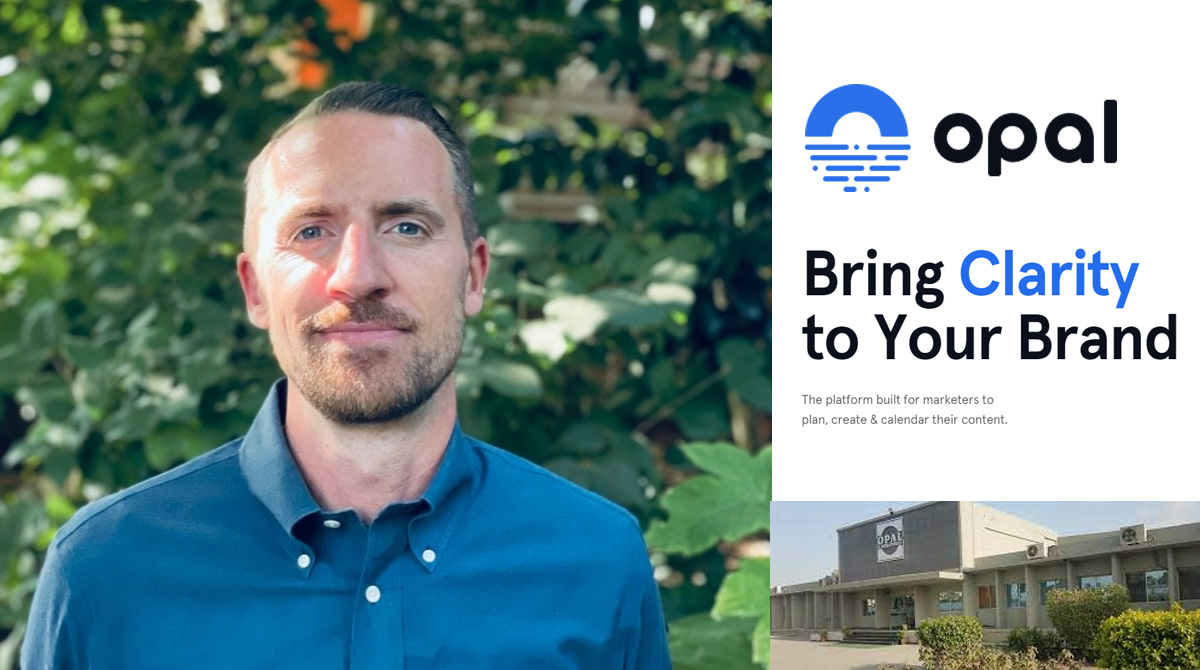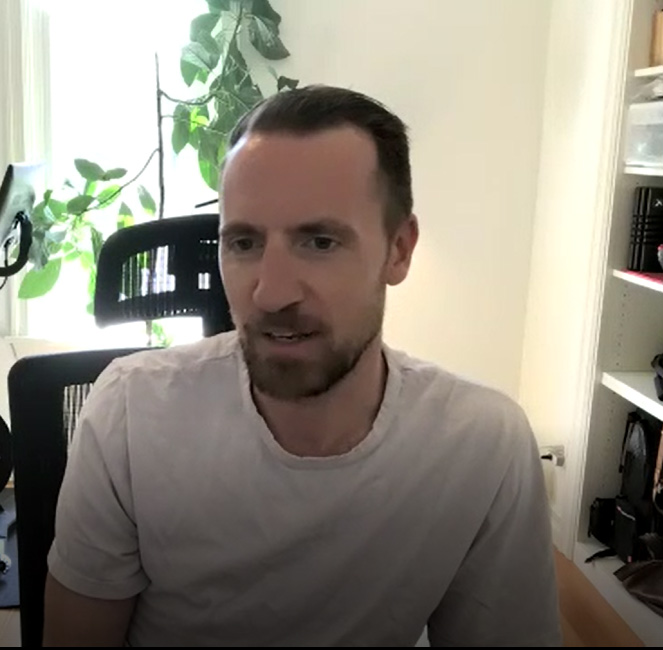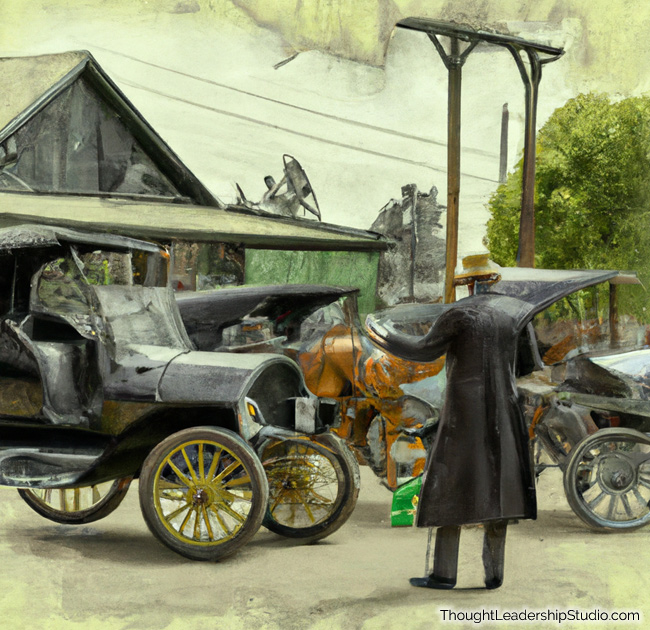Thought Leadership Studio Podcast Episodes:
Interview with George Huff CEO of Opal Labs
Episode 40 - Gain insight into the founding and vision of marketing tech company Opal Labs from its founder

#branding, #contentmarketing, #entrepreneurship, #innovation, #interviews, #leadership, #marketing, #marketingstrategy, #marketresearch, #massinfluence, #socialmedia, #systemsthinking, #thoughtleadershipexamples
Or Click here to listen or subscribe on appWhat this episode will do for you
- Gain insight into the founding and vision of a marketing tech company that distinctively solves a problem.
- Learn some strategies for overcoming the challenges of marketing with a unified message within a large organization.
- Discover inspiration for your own journey in business leadership from George's example.
George Huff CEO of Opal Labs.
George Huff is the CEO of Opal Labs, His leadership style is imprinted across Opal, playing a crucial role in changing the marketing and branding teams' conventional approach globally.
George grew Opal's annual revenue to ultimately surpassing $10 Million and has had numerous successful projects, including partnering with Target to generates 300 pieces of daily marketing content.
Curated Transcript of Interview with George Huff
The following partial transcript is lightly edited for clarity - the full interview is on audio. Click here to listen.
Chris McNeil: So welcome back to Thought Leadership Studio. I'm your host, Chris McNeil, and I'm sitting here, from one coast to another, speaking with George Huff, the CEO of Opal Labs. Welcome, George.
 George Huff: Thank you. Good to be here.
George Huff: Thank you. Good to be here.
What Drove the Founding of Opal Labs?
Chris McNeil: And we had a little bit of a conversation ahead of this interview, and I find what Opal Labs is doing fascinating in helping organizations fully bring a message to life. And can you tell us a little bit about what is behind Opal Labs and, and a little bit of your history and how you came to a place where you would bring something like this to life, George?
George Huff:Yeah, absolutely. I could go back, I could go back all the way to how I just ended up gravitating towards the space of tech and, and brand. You know, I'm really a big fan of how brands come to life, since I was a kid, right? I've always loved a big brand, storytelling, all that stuff. And, I think that as I got into my career, on the outside you look at a brand and there's just all this perfection and veneer around it, right? They're like, "oh, wow, how do they ... like, it must be like that on the inside too.
 And then you get on the inside of these big companies. And it's really hard to be thorough and be consistent and bring all these people that are inside of an organization with all their participants and how they build their brand from a marketing standpoint.
And then you get on the inside of these big companies. And it's really hard to be thorough and be consistent and bring all these people that are inside of an organization with all their participants and how they build their brand from a marketing standpoint.
Seeing how fragmented everything was and seeing how hard it was to actually bring that brand story to life. ..And so, I've been on this mission and Opal's been on this mission to make that a smoother process, to make it easier and really, you know, eliminate a lot of the things that get in the way of brands putting their best foot forward as it relates to marketing.
And so that's really kind of how we got started - or at least the path that I've been on ... many, many, war stories in between now and back then when I got on that path. But, you know at a high level, it's really about how do we help our customers have a place where everything goes in one spot and they're coordinated and aligned and they can focus on the work versus like focus on, all the misalignment that often derails work.
Chris McNeil: Interesting. So you help organizations bring their message into alignment, is one thing I'm getting.
George Huff:mm-hmm. (affirmative). Yeah.
Branding from Top-Down or Outside-In?
Chris McNeil: And that's interesting how you point out the, the veneer of a brand. There's, there's a lot of work behind it, and all the glitters isn't gold sometimes, but there's a lot of thinking that has to go into.... and then of course then there's the market response and does the market respond the way we think it will, or are we designing it from the market response outside in? What are your thoughts on that? "I'm designing a brand according to what the market is saying they want" versus having a vision and then testing it against market response.
George Huff: That's such a fascinating question because I think that it's kind of like gas and brake a little bit. You know, like sometimes you just have the right idea. I don't think anyone's like so in a vacuum that they're not aware of what's going on in culture and whatnot. But, I think like if everything you do is waiting for the market to tell you that the market wants it, I think you're, you're playing it too safe.
Chris McNeil: Mm-hmm. (affirmative).
George Huff:And so I think the brands that end up breaking through do have a point of view, And usually a pretty strong point of view about who they are. and when it works, it's beautiful. So I don't think it's always like one or the other, but I do think that you can almost like believe your own hype too much as a brand. Like where you, you kind of are missing something completely because you have like an arrogant ...so there has to be this like humility where you are paying attention, but if you only are like waiting for permission, you're never gonna take the risks that allow you to, to separate from the pack.
 Chris McNeil: Oh, sure. Who would've told Walt Disney that families would want a Disneyland before he actually came up with it.
Chris McNeil: Oh, sure. Who would've told Walt Disney that families would want a Disneyland before he actually came up with it.
George Huff:Right? It's like, and it's like the, it's like the Henry Ford faster horse story. Right? Same kind of thing.
Chris McNeil: Yeah, absolutely. We want a faster horse, but, here's something that would satisfy those values. So maybe, maybe it's being in touch with values, but the models that bring those values about being innovative with that. So an innovative message as well.
Bringing an Aligned Message to Life
So what do you see, from your perspective - and I know you've put a lot of thought in this to come up with this kind of app and this kind of system that brings these visualization tools to marketing planning - what do you see as the components to bring together to come up with a aligned message that is going to resonate with the market?
Henry Ford and Faster Horses
When someone suggested to Ford that he should ask his customers what they wanted, Ford reportedly replied, "If I had asked people what they wanted, they would have said faster horses."
George Huff: Yeah, I mean, I could riff on this for more time than we have allotted for today, but, um, , I'll try to keep it short as possible. You used a word in there that I think is really important, and it's the word system Marketing, like for this work, right? ... For planning, for understanding what the customer's going to experience. Like for that whole, like for everything that marketing is going to put out there, there's really no system today.
Usually people are cobbling together, like a Trello board or a spreadsheet, or like, whatever the thing is, some kind of general purpose tool that's built for everyone, but not really built for marketing. And so when you kind of step back and say, well, people are trying to achieve these things in these tools today, what are some of those components?
So you need to be able to manage lots of content and its attributes so you can make sure you know what's what and you're organized, right? You need some sense of time, a calendar, being able to look out and, and, and understand, both at a granular level, like when are we gonna publish a tweet all the way up to, in general, or when are we gonna talk about a new product launch or whatever - things like that.
So there's this time component to it. There's this collaboration component to it where the back and forth of the work itself, people need a place to be able to, to talk about that. And having it all kind of be in one place allows you to avoid some of that misalignment.
So like, there's this, there's this basic system component to it, and that's all well and good because I think that when you think about a software product, you think about it being like a set of features that allows you to achieve a job. But what's interesting about thinking about it like a system, especially within an organization is hierarchy, right?
So if I said to you, does your CMO care about, monday.com, if that's what you're using to manage, like your content planning or something like that, right? No, your CMO's like, whatever, I don't care what tools my teams use Like, you think about the direct value that's implied there, um, what they really care about. If your CMO in this space is like, here's my strategy and is my strategy being executed on, and is my strategy working, right?
 Like, it's, it's sort of that, that chain of things. And so with Opal, we, we kind of said, well, what are all these things? Like what if you were to design these things together to actually account for hierarchy in organizations so that people could have their view of how they saw the world and the way they thought connected to the work. And that's really, you know, the vision for what we're doing is connecting strategy to execution through the lens of a plan.
Like, it's, it's sort of that, that chain of things. And so with Opal, we, we kind of said, well, what are all these things? Like what if you were to design these things together to actually account for hierarchy in organizations so that people could have their view of how they saw the world and the way they thought connected to the work. And that's really, you know, the vision for what we're doing is connecting strategy to execution through the lens of a plan.
And in that executional layer, bringing the visual nature of the work to life so that everybody can like say, yes, are we doing this thing for, you know, holiday 2024, and what is this sort of, what, what does everything look like together? And having that be, um, at your fingertips? And I think that it just doesn't exist today.
... And especially not in the way that we're approaching it, but like, you know, kind of stepping back, everything's about efficiency right now. How can we get more for less? How can we, how can we consolidate tools, like all these things that people think about of, of like their efficiency play. Because a lot of people think of efficiency of like, well, thing, uh, uh, we have a content idea goes from point A to point B to point C all the way to Z whatever. And like, let's consolidate those steps so that we can be more efficient.
We think about efficiency. I think that does exist, but it's an also an "and," right? The hierarchy I'm talking about ,that misalignment in hierarchy, is actually probably a bigger disruptor of efficiency than, than anything else. And so that's really like what we aim at and our differentiator, I think, in the market against like a generic platform and tool, is that we're really aimed at, at, at the whole pyramid of marketing to say, how can we help everybody in marketing be more aligned, be more collaborative, and thus drive efficiency?
Chris McNeil: So bringing the team's message together with a tool that makes the process more coherent.
George Huff: Yeah, exactly. More coherent and more in context of the bigger picture. You know, it's one thing to say, Hey, "I'm responsible for social inside of a brand, and I just got my spreadsheet of ideas that I'm constantly tweeting out." Like at it's most kind of basic... All the way to, "Hey, there's also like a request model, like, hey, we're doing a hall, we're doing a Halloween campaign or something, right?"
Like, Chuck over the fence to the social person, and maybe they send out a tweet that's got the, prewritten copy for this thing. And maybe like an image, all the way to, "Hey, this is the strategy and we're all aware of the strategy and we know that we're gonna support it like months in advance."
And so it's just kind of built, it allows people to like build all this stuff into their rhythm and have it kind of, and then seeing it together along the way. I think that most organizations, you know, e every organization's "orged" a little bit differently. Uh, but I think that, that the ones that do the integrated me marketing the best are the ones that are kind of working together from the beginning through the process. And that's really the model we think is the one worth building a product for.
Chris McNeil: So, speaking of alignment and working together and bringing a shared vision to life, how much does that play off of an organization's internal alignment around shared values? ...and shared beliefs, because we talk a lot in Strategic Thought Leadership about helping a segment of the marketplace or helping an audience adopt a new belief system that is going to be empowering for them and helping get more out of whatever the purchase of product or service for, for instance, in the marketplace.
But it could also have, you know, political or social engineering roles, you know. But people are trying to take a, a clear mental model, a clear thought leadership position that is not yet adopted by an audience, but would help them get more of what they want should be adopted. And then there's a process of developing supporting arguments.
How does that kind of process or thinking, where there's a hierarchy of organization in the sense that there is a lead message, but then they're supporting arguments that support the lead message by undermining whatever old thinking we're taking people away from, right? Like the, "we're not riding horses anymore" by Henry Ford because "this is easier".
George Huff: Are you talking about inside of an organization?
Chris McNeil: Yeah. I'm talking about how to, how to, how to really get everybody aligned so that all these supporting arguments that people come up with - their ideas for content, so to speak - are in alignment with the lead message of an organization.
George Huff: Yeah. I gotcha. A lot of times we work with organizations that are like massive, and then we work with organizations that are smaller, right? And, and the ones that are smaller, it's just like a, it's like a different set of problems they have. The one like that, that sort of political problem that you, you speak to is definitely evident. Like, we can't ignore politics inside large organizations. And so for us, you know, it's not even just content ideas, right?
It's like, "Hey, we built a special tool in-house for this thing that this seems like that's what this other company you're trying to tell us to like, pay attention to". For us, I think it's a gradual thing to change if you're kind of working from the bottom up inside of an organization.
If you're working from the top down, you know, companies have to know what they're about. Like what are their values? What, what do they stand for? Like, you know, one of the things that, that we, we run into a lot. Right now I'm working with a large organization, and they're starting to use words like, "we want to be more collaborative, we want to be more agile, we wanna be more aligned" and, less silo, like knock down the silos.
So there's like these concepts that I think the old guard kind of limits you from going into that, right? Because people have their little fiefdoms or whatever. So I think that's something that we navigate at every single organization. Every single organization looks a little bit different. We've learned so much from a product perspective on things like opinions.
With Opal for instance, we started out saying," oh, everything has to be this way" because when you first start, you design a product after the organizations you first work with, right? So you're like, "oh, this is how you do it." But then you kind of go to a different organization or different set of organizations and, you know, it could be different verticals, right?
We got a really big start with like, consumer retail, and now we work with a lot of healthcare companies and they just think about things differently. And so you, you have to build a system that's significantly more flexible, to help with like these different styles. Because when you meet those different individual groups, like one group's like, well, "we work this way and adopting this tool would be not only adopting a new tool, but changing the way we work and we don't wanna change the way we work." You know?
"This is sort of greater than everyone being aligned. We don't really care about that.: You know? So like, I think the top down pressure plus how we go about it with the flexibility side is, is how, how we navigate those spaces. But it's not easy. At all.
Chris McNeil: And I could talk these kinds of things all day long too, but I feel like I should play the listener advocate role a little bit and reel us in a little bit, and maybe take it out of the abstract: If you could tell a story of a specific example - with what, of course, you're comfortable sharing in the podcast - about how you help bring this about - either in your own company or for a customer, or both.
Hierarchical Challenges and the Need for Top-Down Support
George Huff: Yeah, without naming names of customers, I've seen this work out a few different ways. So, oftentimes when we sell, if I think about a pyramid in a hierarchy, there's sort of like executive layer, there's ICs and there's mid-level management. A lot of times mid-level management are the ones who bring Opal in to be like, let's do this thing. And they kind of check the boxes and say, Hey, we've checked the boxes with our ICs, you know, with enough or whatever. We think this is a worthy thing. So, we were working at a company -and again, I'm not, I'm not super inclined to name names - but let's just say that they're a big consumer tech travel company, and they got buy-in.
 They got enough buy-in from the C-suite, right? They, they're like, okay, let's try this thing out. But there was never the oomph behind it. There was never accountability around it. There was never a why we're doing this. It was just sort of kind of like, we bought this tool, now we're gonna start rolling out the teams. And it kind of, and then it became of like, why are we adopting this? Who are we doing? And so, like, when you see that change management happen, you would think at a technology company that, like, they would just know how to adopt tools, but like, humans still exist at those companies that have their own ways of doing things in their own political layer - like I contrast that with a large aerospace company that's been around for a long time.
They got enough buy-in from the C-suite, right? They, they're like, okay, let's try this thing out. But there was never the oomph behind it. There was never accountability around it. There was never a why we're doing this. It was just sort of kind of like, we bought this tool, now we're gonna start rolling out the teams. And it kind of, and then it became of like, why are we adopting this? Who are we doing? And so, like, when you see that change management happen, you would think at a technology company that, like, they would just know how to adopt tools, but like, humans still exist at those companies that have their own ways of doing things in their own political layer - like I contrast that with a large aerospace company that's been around for a long time.
And we went there and it, we got to the C-suite. And I'm, I'm pitching in a room, it's probably one of like one of the coolest pitches of my life because it's like, C-level executives and like a lot of, VP,, senior vice presidents, director level, senior director level folks, probably 30 people in a room, and pitching and saying, Hey, this is what we do. This is why we do it. This is the problems we're looking to solve, and this is how it relates to you. The senior executive, she looked around the room and she goes, okay. She's like, "This seems like a problem we've been trying to solve for a long time, is there anybody that's not in on this? No. Okay, we're doing it."
Let's figure out a way to get it done. And that was that, right? And everybody kind of fell in line. And so you kind of, you know, if you're trying to fight those battles, those political ones from the middle out really hard, but if you're, if you can find, you know a sort of a group of people that are buying into something and can, and press things down, then you, you give yourself enough time to make that change happen. Anyway, it's just that contrast of two different worlds. And I think that people, people forget how important hierarchy is in these sort of software rollouts.
Chris McNeil: Oh, yeah. I'm hearing that it really pivots on support from the top.
George Huff: Yeah. Support from the top. And it's just like being really buttoned up. I mean, I, I was blown away. I probably worked with one of the best project managers in my life that I'd ever seen at this other deploy at this sort of aerospace deployment company, because they put people on it to make it happen.
I think a lot of people think, well, if the software's easy, people will just start using it. But like humans, there, there's like a whole bell curve of humans like, you know, acceptance for change. Like some people are like, I'm always trying the new thing. And some people are like, I never want to try anything new, you know, at the other end. And, you know, a whole group of people in between.
And I think, you know, you just have to nudge it enough to get it going. That creates the critical mass that moves the needle with, with software and stuff like that, any kind of change really.
.............
The transcript is lightly edited for clarity and is a partial transcript- the full interview is on audio. Click here to listen.
***************************************
Free Stuff and Offers Mentioned in Podcast
***************************************
***************************************